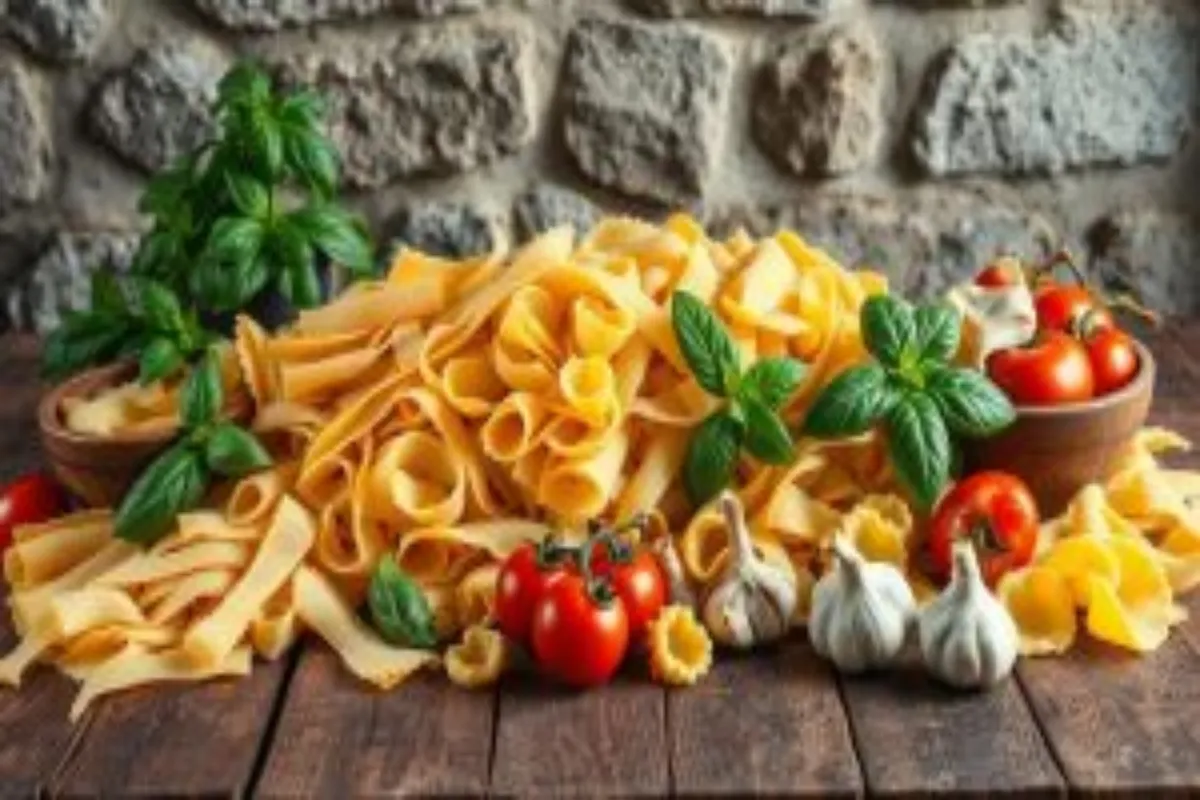Pasta is a favorite food worldwide, with a deep pasta recipes from history that goes back thousands of years. It started in ancient times and has become a key part of many cuisines. This article takes you on a trip through time, showing how pasta was important in early diets and how it changed over time.
We’ll look at how different regions made pasta and its cultural role. You’ll learn about the history of pasta and how to make these classic dishes at home.
Key Takeaways
- Pasta has a fascinating history that dates back to ancient civilizations.
- Understanding ancient pasta recipes provides insight into early dietary habits.
- Regional variations in pasta recipes highlight diverse culinary traditions.
- The evolution of pasta reflects changes in agricultural and cultural practices.
- Reviving these recipes in modern kitchens bridges the gap between past and present.
The Origins of Pasta
The story of pasta goes way back to ancient times. It started with the Etruscans and Greeks, who loved it. They even wrote about it in old texts.
One such text talks about ‘lagane’, a dish like our lasagna today. This shows how important pasta was in the Roman Empire. It was a big deal in their culture and food.
Pasta grew popular in places where different cultures mixed. The Mediterranean was like a big kitchen where foods and cooking ways blended. This mix led to many types of pasta we know today.
Archaeologists and old books tell us how pasta changed over time. Recipes and cooking methods from back then show us how cultures shared ideas. These early steps helped make pasta a favorite food worldwide.
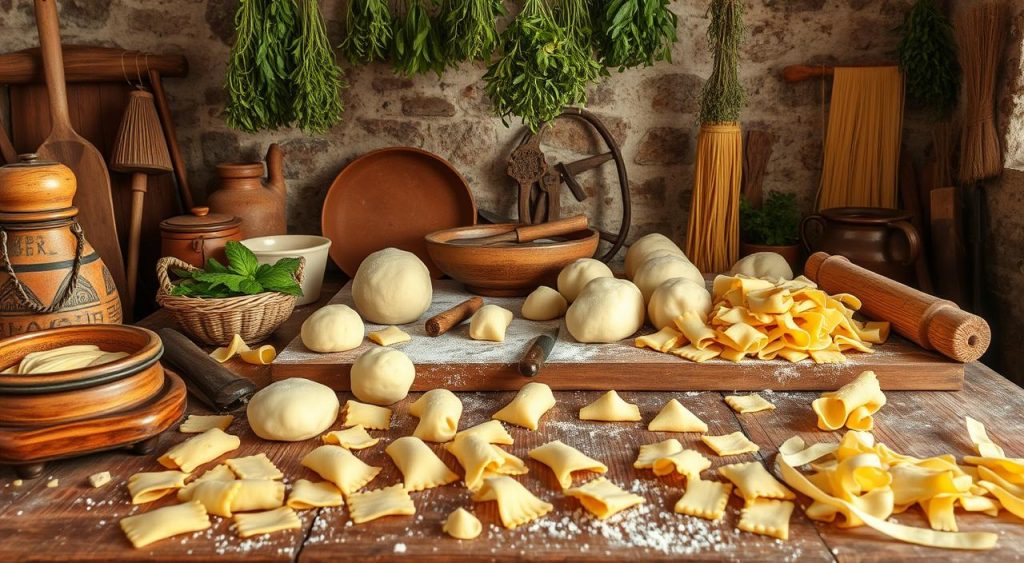
Pasta in Ancient Civilizations
Pasta has a long history in ancient cultures, affecting diets in Mesopotamia, Egypt, and Rome. Archaeologists found evidence that these societies loved pasta, using it in meals and celebrations.
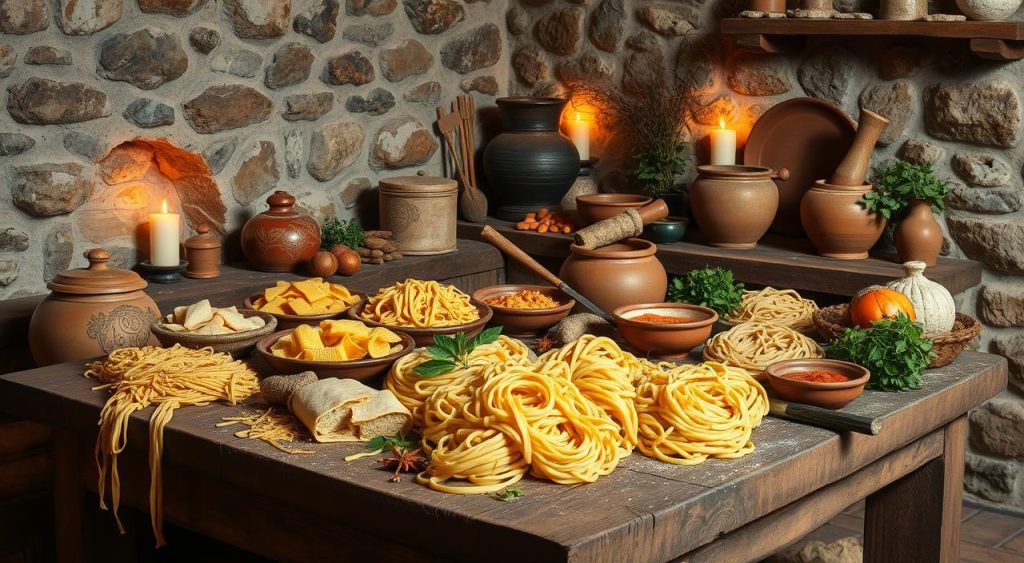
In Mesopotamia, people ate pasta-like dishes made from grains. These were boiled and mixed with sauces. This shows how ancient people enjoyed pasta in many ways, using what was available.
The Egyptians also made pasta dishes with grains. They ate it during big events or as part of religious activities. This shows how pasta was key in their diet and social life.
In Rome, pasta was a common food for everyone, rich or poor. Old texts talk about many pasta recipes made with fresh ingredients. This shows how versatile and loved pasta was.
Pasta became a big part of ancient diets, showing its lasting effect on food history. Through cultural sharing and new ideas, pasta became a symbol of community and celebration in many places.
Early Ingredients and Preparation Techniques
At the heart of early pasta making were simple yet key ingredients for ancient pasta. Wheat and water were the main ingredients, easy to find in ancient times. These ingredients were turned into food by the cleverness of early people.
Traditional pasta preparation techniques varied by region and what was available. Many used hand-rolling, which made pasta of different thicknesses. This showed off each cook’s skill. These methods also changed how sauces worked with the pasta.
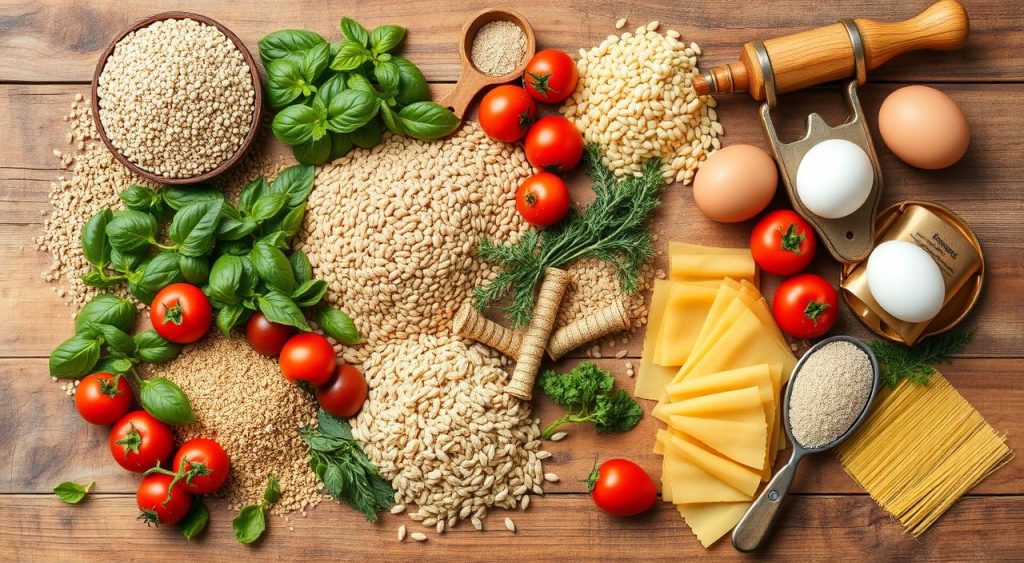
As pasta changed, so did the early cooking methods. Ancient people dried pasta to keep it for a long time. Scholars say this helped pasta become popular all over the world. The easy-to-get ingredients made pasta a favorite in many cultures.
For more on pasta’s history, check out this in-depth look at its interesting story.
The Influence of the Silk Road on Pasta
The Silk Road was a key network of trade routes. It helped spread pasta far and wide, mixing it with local ingredients and techniques. Traders and explorers shared food knowledge and recipes, making pasta a global dish.
Historical figures documented how flavors and cooking methods mixed on the Silk Road. Ancient texts show how pasta changed, blending Eastern spices with Mediterranean flavors. This Silk Road influence led to a wide variety of pasta dishes, fitting different tastes and cultures.
- Spices and herbs made new pasta sauces.
- New cooking techniques came from cross-cultural exchanges.
- Migrants brought their pasta styles to new places.
Thanks to the Silk Road, pasta spread across Asia and Europe. Over time, these exchanges shaped pasta into what we know today. It’s now a key part of many cuisines around the world. This history shows how pasta’s versatility and how traditions connect through shared experiences.
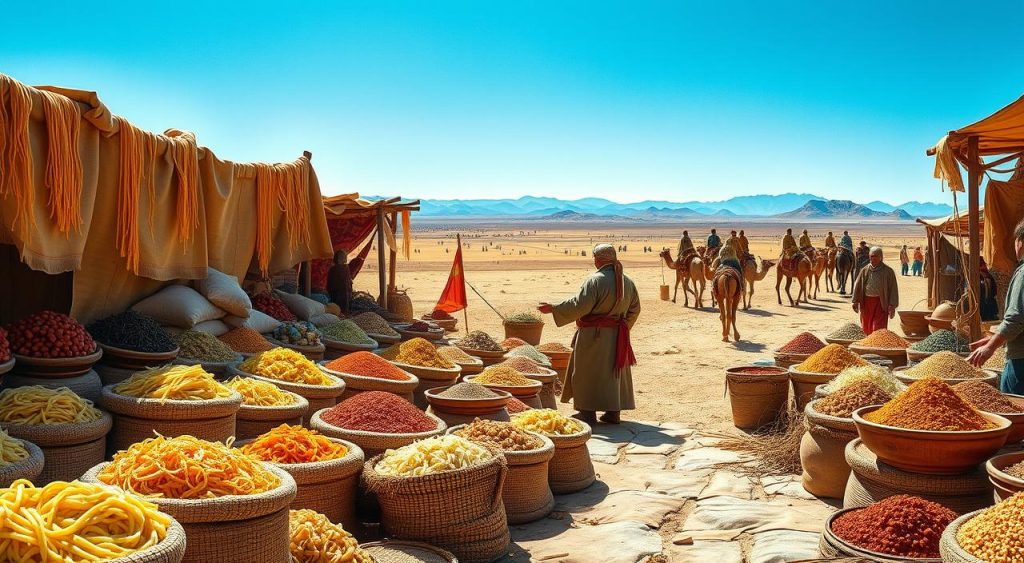
Traditional Roman Pasta Recipes
Ancient Roman cuisine shows us the rich history of Italy, with pasta at its heart. Some traditional Roman pasta dishes are still loved today. They use unique ingredients and cooking methods that were common in ancient Roman kitchens.
Famous Roman Pasta Dishes
Pasta e ceci and lagane e ceci are two well-known Roman pasta recipes. Pasta e ceci combines pasta with chickpeas for a filling meal. Lagane, a flat pasta, is often used in soups or stews, showing the creativity of ancient Roman cooking. These dishes highlight the use of seasonal ingredients by Roman cooks.
Cooking Methods of Ancient Rome
Boiling and frying were key cooking methods for these dishes. Archaeological discoveries show us pots made for boiling water to cook pasta well. Frying added texture and flavor to meals. These techniques brought out a variety of tastes and showed the value of simple cooking in ancient Rome.
Pasta Recipes from History
The medieval period was a big step forward for pasta recipes. It made this food what we love today. Cooks started trying new ingredients and methods, creating many medieval pasta recipes. These dishes showed the mix of flavors from different places.
They also showed how chefs were creative and clever back then.
Medieval Pasta Innovations
In the medieval era, pasta became a key food in many European homes. Cooks started using local herbs, spices, and tomatoes to make sauces. This made pasta dishes full of taste and color.
Baked pasta dishes also became popular, cooked in ovens to make warm, filling meals. ‘The Art of Cookery’ shows the wide range of pasta recipes from back then. It tells us how different cultures mixed to create new dishes.
Regional Variations in Ancient Recipes
Each region had its own way of making pasta, using what was available. In the north, durum wheat made pasta with special textures and tastes. In the south, local produce led to rich tomato sauces.
Here are some examples of these regional styles:
- North Italian Pasta: Known for thick noodles and creamy sauces.
- Southern Italian Pasta: Famous for light, tomato-based sauces and fresh veggies.
- Spanish Pasta: Uses spices and ingredients from the Moors, mixing flavors from different cultures.
The Role of Pasta in Ancient Diets
Pasta was a key part of many cultures, playing a big role in ancient diets. Its simple ingredients made it easy to get and use in many dishes. During hard times, pasta was a trusted food, showing its importance in the diets of different peoples.
Nutritional Value of Early Pasta
Early pasta was full of nutrients that were important for health. Made from grains, it was a great source of carbs, which gave energy. In ancient times, people needed a lot of calories, and pasta gave them that.
It also had protein from vegetables and legumes, making meals more balanced.
Some key aspects of early pasta include:
- High caloric content, essential during physically demanding periods.
- Rich in carbohydrates, serving as a primary energy source.
- Varied preparations that allowed for the incorporation of local ingredients, enhancing nutritional diversity.
Pasta was not just a meal; it showed how people used their land and what they ate. Its ability to adapt made it a staple in ancient diets, keeping it important in daily life.
The Transition of Pasta Through the Ages
The story of pasta is fascinating, showing how it changed over time. It went from simple beginnings to being a key part of the Renaissance. This change was influenced by big events and people moving around.
Back in ancient times, pasta was made with simple ingredients. As different cultures mixed, cooking ways changed. This led to the wide variety of history of pasta dishes we see now. The 19th century brought new machines that made making pasta easier for everyone.
When people moved to new places, they added their own flavors to pasta. This brought fresh herbs and veggies into the mix, making pasta taste better. This change showed how pasta was made and enjoyed in different ways by different people.
Important changes helped shape pasta over the years. New ways of cooking made pasta taste better and feel different. Better farming made grains better, leading to new kinds of pasta dishes.
Today, pasta is a key part of food around the world. It shows how pasta has changed and stayed popular over time. If you’re into trying new foods, you can find high-protein pasta recipes. These show how old ways of cooking still influence what we eat today.
Reviving Ancient Pasta Recipes Today
Bringing back ancient recipes makes meals more special, showing us the history of food. Today’s cooks can learn from the past and enjoy the tradition of pasta. Many old recipes can be updated for today’s tastes, keeping their unique taste and feel.
How to Prepare Historical Pasta at Home
To make pasta like it was in the old days, follow these steps:
- Select Ingredients: Choose top-quality flour, like durum wheat, and fresh eggs.
- Create the Dough: Mix flour and eggs, knead until smooth. Let it rest for 30 minutes.
- Shape the Pasta: Roll out the dough and cut it into shapes like tagliatelle or pappardelle.
- Cook in Boiling Water: Boil until it’s al dente, just a few minutes for fresh pasta.
Modern Adaptations of Ancient Recipes
Today’s chefs update old recipes to make them appealing to us now. They add new ingredients or sauces to classic dishes like spaghetti. These updates keep the pasta’s roots while fitting into today’s food trends.
Exploring Cultural Significance of Pasta
Pasta is more than just food; it’s a symbol of community and tradition. In many cultures, it’s a key part of celebrations like weddings and holidays. It shows how important pasta is in our cultural heritage.
Pasta brings families together, often being the main dish at meals. People share stories and enjoy classic recipes passed down through generations. These moments show the deep emotional connection pasta has in traditions around the world.
- Italy: Known for its wide variety of pasta, each region has its own unique dishes that reflect local customs and ingredients.
- China: Noodles, a type of pasta, are important in celebrations, like birthdays, where they symbolize a long life.
- Mexico: Pasta is used in dishes like sopa seca, showing how it fits into local tastes and cooking styles.
Global pasta dishes show how this food adapts to different cultures, using unique ingredients and cooking methods. From creamy fettuccine Alfredo in the U.S. to spicy pad thai in Thailand, each dish tells a story of its creators.
Scholars have studied how pasta reflects social identity through sociology and ethnography. The food we choose to eat shows our cultural background, values, and history. So, pasta is a key part of human connection and diverse food cultures worldwide.
The Future of Pasta: Lessons from History
Looking at the future of pasta, we see that history offers great insights. Historical pasta recipes show us the local ingredients, cooking ways, and cultural mix of the past. By learning from these, today’s chefs can make new dishes that appeal to us now.
Today’s pasta trends show a move towards being green and health-focused. Many are using flours like chickpea or whole grain, just like our ancestors did with local ingredients. This change meets today’s tastes while honoring the past.
Bringing back old recipes inspires us and links past and present cooking. For example, the rise of fermentation and preservation in making pasta today connects us to the past. These methods focus on quality and taste, not just making a lot.
In short, the future of pasta teaches us to innovate while valuing old ways. The mix of new cooking trends and historical lessons promises an exciting future for pasta in food.
Conclusion
Pasta’s history is a rich tapestry of cultures and time. It started with the Etruscans and Romans, then changed with trade routes like the Silk Road. This shows how pasta has grown, reflecting social and economic changes.
Looking at ancient recipes, we see pasta-making’s deep roots in tradition. Each recipe tells a story, linking us to our ancestors. It makes us value the flavors and tales behind these dishes.
In the end, pasta’s legacy in food is clear. By exploring ancient methods and regional recipes, we celebrate its history. Pasta’s past inspires new culinary adventures, for today and tomorrow.
FAQ
What are some ancient pasta recipes I can try at home?
You can try making ‘lagane e ceci’ from ancient Rome or ‘pasta e ceci.’ These dishes use simple ingredients like wheat and legumes. They show how people cooked back then.
How did the Silk Road influence pasta?
The Silk Road was key in sharing foods between cultures. It spread pasta far and wide, bringing new tastes and ways of cooking to different places.
What was the nutritional value of pasta in ancient diets?
Pasta was a main food in ancient times. It gave people the nutrients and energy they needed for their daily lives. It was especially important during hard times.
How did pasta evolve throughout history?
Over time, pasta has changed a lot. It started in ancient times and has grown into the many types we know today. It has been shaped by local ingredients and tastes.
Can I recreate historical pasta recipes using modern ingredients?
Yes, you can make ancient pasta recipes with today’s ingredients. Modern chefs update these old recipes, keeping their original flavors alive in our kitchens.
What role has pasta played in different cultures?
Pasta is important in many cultures around the world. It’s often eaten in celebrations, with family, and in traditional dishes. It shows the traditions and values of different societies.
What were the common cooking methods used in ancient Rome for pasta?
In ancient Rome, people boiled and fried pasta. These simple methods are still used in Italian cooking today.

